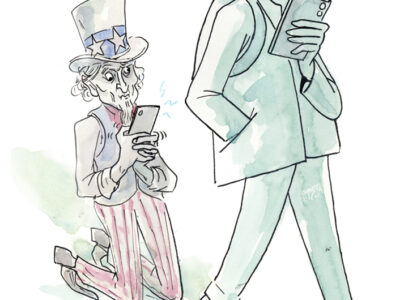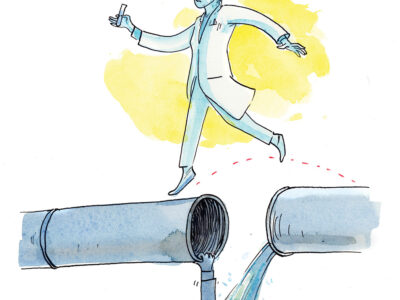
Everything you wanted to know about the bird of Thanksgiving
By William Young | In the United States, turkeys are closely associated with Thanksgiving, which sometimes is called Turkey Day. The early British colonists enjoyed a feast with native people who brought wildfowl, including wild turkeys. But according to John Madson in a 1990 Smithsonian magazine article, the Indians scorned turkey meat and thought turkeys were game fit only for children. Madson wonders whether the Indians brought the turkeys to the feast just to get rid of them.
Wild turkeys are in the same family as chickens, pheasants, and partridges. Turkeys get their name because the British, who were confused about the country of origin of these imported birds, had bought a similar-looking bird called a guineafowl from Turkish traders. (Neither guineafowl nor guinea pigs come from Guinea.) People from the country of Turkey, as well as France, the Netherlands, and Scandinavia, have given names to the turkey based on the belief that it came from India, while the Greeks call turkey “French chicken.” In Swahili, the word for turkey is translated as “great duck.”
Domestic turkeys do not have a positive image. Contrary to legend, they do not drown by standing in the rain with their mouths open. Still, turkey is a derogatory term to describe a stupid person. Turkey also is a term for a bad theatrical production. The origin of this meaning comes from the habit of theater managers introducing plays of dubious quality around Thanksgiving, because a greater number of uncritical people attend plays during the pre-Christmas theater season.
I once wrote a review of Wild Turkey Country, a book by Lovett E. Williams Jr. It includes a lot of detail, including how to look at turkey excrement and identify the sex of the bird who left it: males have long, straight, or J-shaped droppings, while females have curled or bulbous droppings. Williams explains that Wild Turkeys were domesticated by the early Mexicans and taken to Europe by Spaniards. They were bred in Europe and later carried back to North America by British colonists. A newly hatched turkey imprints on the first large moving object it sees. Williams theorizes that the Mexicans might have been able to domesticate Wild Turkeys by imprinting them on humans. A Central American species called the Ocellated Turkey is more ornate than the North American species. It has never been domesticated.
Before Europeans came to the New World, Wild Turkeys were abundant in about three-quarters of the area that now includes the lower 48 states. By the mid-1900s, turkeys had been wiped out by excessive hunting in about a dozen states and were restricted to small ranges in many others. In recent decades, turkeys have been reintroduced into areas from which they had been eliminated. Williams says that reintroduction programs have been successful, because unlike many other species, Wild Turkeys lack a homing instinct. If you capture and transport turkeys, they will establish a home at the new site rather than trying to return whence they came.
With suburban sprawl, wild turkeys are increasingly being seen in suburban neighborhoods. In 2011, a friend in the Northern Virginia suburbs who put a webcam in her yard for recording the songbirds who visit her pond captured footage of a Wild Turkey coming in for a drink. A 1999 New York Times story reported that an animal control officer in Princeton, New Jersey, was called by a woman who claimed to have an endangered species in her yard. The officer went to her house and found a non-endangered turkey. The next day, the woman called again and said she wanted the turkey out of her yard. When the officer asked why, she said, “It’s eating the bird seed.” The officer replied, “Well, it’s a bird!”
Wild Turkeys are wily birds and not easy to find. They are one of the heaviest native species in the United States, along with swans. The males weigh more than 20 pounds, and the females are about half that size. Young turkeys and other young fowl are called poults, which is why the birds raised on farms are called poultry. When giving sexual displays, the male Wild Turkey is quite impressive, puffing out his feathers, fanning his tail, and strutting around. His neck is carunculated, which means it has bumpy bare skin. He sprouts strange hair-like feathers from his breast that can be more than a foot long and collectively look like the tassel on a graduation cap. And he has a growth called a snood over his bill, named for the little bag in which some women wear their hair.
While partridges in the wild do not show a strong preference for perching in pear trees (even around Christmas), turkeys sometimes perch in trees. Their willingness to do so makes them more difficult for hunters to pursue than some of the other birds in their family. The chicken-like birds have short, rounded wings adapted for brief bursts of flight to escape from predators. Because the birds have heavy bodies and short wings, they have to flap very hard and fast to become airborne. Some hunters use dogs to chase these birds and flush them repeatedly. For species that prefer to remain on the ground, the repeated flying drains the birds of energy, eventually making them easy for the hunters and dogs to catch.
The Australian Brush-Turkey is unrelated to the American Wild Turkey. It looks like a solid-black turkey with a bald red head. The male has a yellow or lavender wattle around his neck that resembles an Elizabethan collar. Brush-turkeys, who are common and tame in many Australian rain forests, are part of a family called the megapodes, which means “great feet.” Male megapodes use their strong feet to kick together large mounds of leaves and plant material in which the female lays her eggs. The heat in the mound allows the eggs to incubate. Although the male is diligent about regulating the heat of the mound to insure hatching, neither he nor the female has anything to do with raising the young. When an egg is ready to hatch, the chick must break out of the shell and dig its way out of the mound. Once the chick finds daylight, it fends totally for itself. From the moment they are born, brush-turkeys and other megapodes are the most independent and self-reliant birds in the world. In general, bird species whose young are better able to function shortly after hatching come from proportionally larger eggs that have a higher percentage of yolk and take longer to hatch, which allows the chicks to grow stronger and take in more nourishment within the egg. Likewise, the more developed the chicks are when they come out of the egg, the larger the number of eggs the female(s) generally will lay, because the young do not need as much care.
When I was a student at Penn, I wrote a letter to The Daily Pennsylvanian suggesting that the school change its nickname from the Quakers to the Turkeys. I thought that choosing a religious group as a nickname was insensitive; I could not imagine calling the sports teams the Penn Jews, the Penn Roman Catholics, or the Penn Jehovah’s Witnesses. Also, I had gone to a Quaker school for 13 years before attending Penn, and I thought Penn students should not yell “Fight, Quakers, Fight” during sporting events, considering the peaceful ways of the Quakers. I suggested the new nickname Turkeys, because Benjamin Franklin, Penn’s founder, so loved the Wild Turkey that he wrote to his daughter in 1784 that it should be the national symbol instead of the thieving Bald Eagle selected by the Continental Congress in 1782. One wonders whether the United States would have adopted different domestic and foreign policies were its symbol a bird associated with food and plenty rather than a bird with arrows in its talons.
William Young C’73 is the author of The Fascination of Birds: From the Albatross to the Yellowthroat, from which this essay is reprinted with permi s sion of Dover Publications, Inc. The book features essays about 99 types of birds and their role in both nature and human culture. He lives in Arlington, Virginia.




